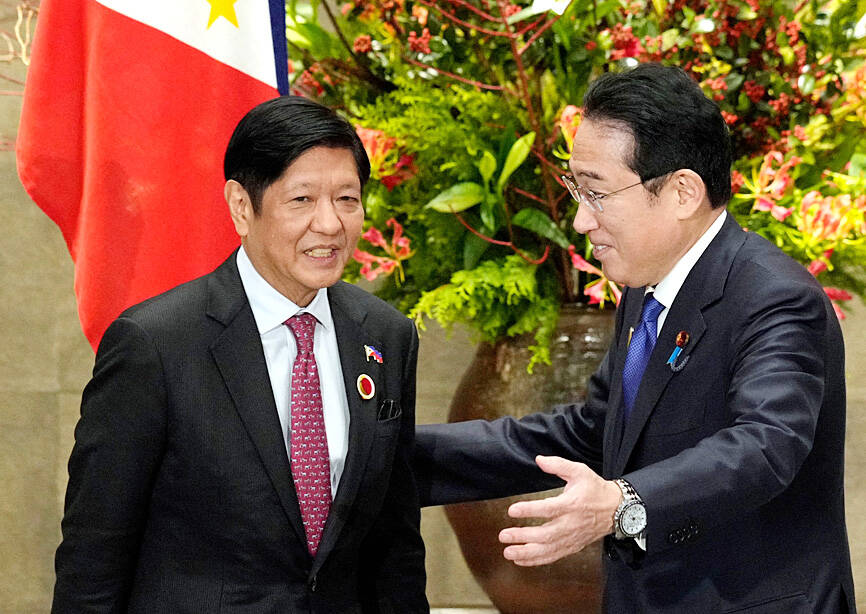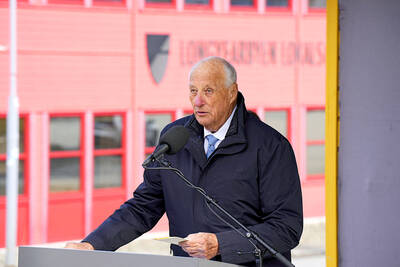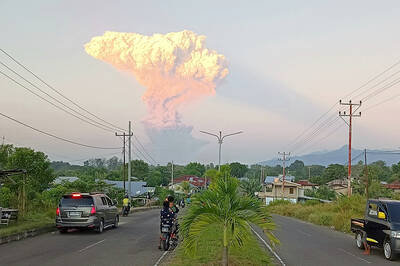A tiny island in the South China Sea symbolizes the struggle — and disparity — in the Philippines’ efforts to assert its rights in disputed waters when compared with China, which claims much of the sea.
Manila is rushing to develop 33-hectare Thitu Island (Jhongye Island, 中業島), with the government planning to pour in billions of pesos to upgrade it.
More than 200 civilians and military personnel reside on the island, but just 27km southwest of it China has built a fully functioning military base on Subi Reef (Jhubi Reef, 渚碧礁) that is estimated to be 12 times the size of Thitu Island.

Photo: AFP
That base is just one of Beijing’s 27 outposts in the South China Sea equipped with ports, runways and other infrastructure aimed at asserting its sweeping claims in the key waterway. In contrast, Manila occupies nine features that have few facilities or structures. Taiwan, Malaysia and Vietnam also have a presence in the area, and overlapping territorial claims.
This disparity explains, in part, the Philippines’ urgency in bolstering its defense alliances, most notably with the US.
Philippines President Ferdinand Marcos Jr has, over the past year, moved to assert his nation’s rights in the waters and he has been backed by unstinting US support.
Marcos is to meet US President Joe Biden and Japanese Prime Minister Fumio Kishida in a trilateral summit at the White House on Thursday aimed at strengthening ties. Both Japan and the Philippines are treaty allies of the US.
On a recent visit to Thitu Island — which is also known as Pag-asa, the local word for hope — arranged by the Philippine Coast Guard, Bloomberg News saw first hand just how underdeveloped the Philippines’ largest-occupied feature in the disputed sea is.
Much of the island is still unpaved, with mobile phone and Internet signals hard to come by. There is still evidence of the destruction caused by a 2021 typhoon — school buildings with damaged roofs and windows that are unusable.
Given its location — nearly 450km from Palawan province — residents sometimes wait days for basic supplies such as noodles, coffee and soap to be ferried in. The Philippine Coast Guard’s new monitoring station appears largely rudimentary.
Still, the Southeast Asian nation is determined to maintain a civilian and military presence on Thitu Island. Aircraft can now land on its runway after repairs and an expansion. A landing dock and a port have also been built, and construction is in full swing to extend the island farther into the sea. There are plans to equip the area with a naval port and radars.
Manila also recently sent researchers to check marine resources near Thitu Island, yet another step to assert its rights in disputed waters.
The research initially found dead corals and small species of fish that suggest environmental degradation in the vicinity of the island, but did not directly attribute the findings to Beijing’s presence in the area.
“Our overarching strategy involves continuous enhancement of facilities, modernization efforts, and fortification of assets and capabilities,” Philippine military spokesperson Colonel Francel Margareth Padilla said when asked about plans for Thitu Island. “These measures are vital in upholding our sovereignty over Philippine territorial waters.”
These Philippine attempts are likely to draw opposition from China, which has refused to recognize a 2016 arbitral ruling that dashed its expansive claims. Beijing maintains a constant watch on the island, and its coast guard and militia ships regularly patrol close to Thitu Island. Some of the vessels were involved in a tense encounter over nearby sand bars.
“At first, this was intended to coerce the Philippines into abandoning the upgrades,” said Gregory Poling, who directs the Southeast Asia program at the Center for Strategic and International Studies in Washington. “Now, it seems meant to merely intimidate the Philippines, but with little chance of success.”

BOMBARDMENT: Moscow sent more than 440 drones and 32 missiles, Volodymyr Zelenskiy said, in ‘one of the most terrifying strikes’ on the capital in recent months A nighttime Russian missile and drone bombardment of Ukraine killed at least 15 people and injured 116 while they slept in their homes, local officials said yesterday, with the main barrage centering on the capital, Kyiv. Kyiv City Military Administration head Tymur Tkachenko said 14 people were killed and 99 were injured as explosions echoed across the city for hours during the night. The bombardment demolished a nine-story residential building, destroying dozens of apartments. Emergency workers were at the scene to rescue people from under the rubble. Russia flung more than 440 drones and 32 missiles at Ukraine, Ukrainian President Volodymyr Zelenskiy

COMPETITION: The US and Russia make up about 90 percent of the world stockpile and are adding new versions, while China’s nuclear force is steadily rising, SIPRI said Most of the world’s nuclear-armed states continued to modernize their arsenals last year, setting the stage for a new nuclear arms race, the Stockholm International Peace Research Institute (SIPRI) said yesterday. Nuclear powers including the US and Russia — which account for about 90 percent of the world’s stockpile — had spent time last year “upgrading existing weapons and adding newer versions,” researchers said. Since the end of the Cold War, old warheads have generally been dismantled quicker than new ones have been deployed, resulting in a decrease in the overall number of warheads. However, SIPRI said that the trend was likely

‘SHORTSIGHTED’: Using aid as leverage is punitive, would not be regarded well among Pacific Island nations and would further open the door for China, an academic said New Zealand has suspended millions of dollars in budget funding to the Cook Islands, it said yesterday, as the relationship between the two constitutionally linked countries continues to deteriorate amid the island group’s deepening ties with China. A spokesperson for New Zealand Minister of Foreign Affairs Winston Peters said in a statement that New Zealand early this month decided to suspend payment of NZ$18.2 million (US$11 million) in core sector support funding for this year and next year as it “relies on a high trust bilateral relationship.” New Zealand and Australia have become increasingly cautious about China’s growing presence in the Pacific

Indonesia’s Mount Lewotobi Laki-Laki yesterday erupted again with giant ash and smoke plumes after forcing evacuations of villages and flight cancelations, including to and from the resort island of Bali. Several eruptions sent ash up to 5km into the sky on Tuesday evening to yesterday afternoon. An eruption on Tuesday afternoon sent thick, gray clouds 10km into the sky that expanded into a mushroom-shaped ash cloud visible as much as 150km kilometers away. The eruption alert was raised on Tuesday to the highest level and the danger zone where people are recommended to leave was expanded to 8km from the crater. Officers also